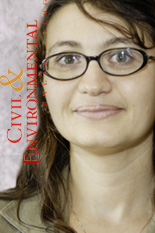"Estimating drivers’ willingness to pay for HOT lanes on I-495 in Maryland"
Cinzia Cirillo - PI
Civil & Environmental Engineering
A number of new road pricing projects have emerged in the U.S. over the past decade. Currently, 35 of the 50 states have some sort of road pricing project in the planning or implementation stage. One promising approach in implementing road pricing is to convert existing under-utilized high occupancy vehicle (HOV) lanes to high occupancy toll (HOT) lanes. The development of HOT lanes can bring new revenues and pricing incentives to road users by essentially auctioning off space on existing HOV lanes. However, policy makers have always been hesitant to adopt HOT lanes due to insufficient political support. One of the reasons is because it is believed that the HOT lanes will mainly benefit travelers with high incomes due to their high valuation of travel time saving.
In the recent past, the State of Virginia has approved the HOT Lanes Project and has started major infrastructure enhancements to the Beltway (I-495). The project includes two new lanes in each direction from the Springfield Interchange to just north of the Dulles Toll Road and the replacement of more than $260 million in aging infrastructure. This includes replacing more than 50 bridges, overpasses, and major interchanges. HOT lanes will operate as tolled lanes alongside existing highway lanes to provide users with a faster and more reliable travel option. Buses, carpools (HOV-3), motorcycles and emergency vehicles will have free access to HOT lanes. Drivers with fewer than three occupants can choose to pay to access the lanes. Tolls for the HOT lanes will change according to traffic conditions to regulate demand for the lanes and keep them congestion free - even during peak hours. (www.virginiahotlanes.com)
On the Maryland side of the Beltway discussions about HOT lanes as a possible strategy to reduce congestion and collect revenues for other major infrastructure investments is at a much earlier stage. Therefore, with this project we propose to investigate the acceptability of HOT lanes and the willingness to pay for their use from the traveler perspective. In particular, we aim at formulating a model system that simulates individual behavior in response to HOT lanes on I-495 in Maryland. The project will utilize state-of-art and advanced discrete choice models to calculate the number of riders that will be willing to pay to use HOT lanes, the distribution of the willingness to pay and the main factors affecting their choices. Furthermore, our objective is to capture the ability of travelers to change their behavior in response to congestion pricing and their flexibility to accept more sustainable way to access work, shopping and leisure places. Finally the project team intends to establish a continuous dialog with local State agencies in order to adapt our modeling tool to their needs in terms of policy analysis.

